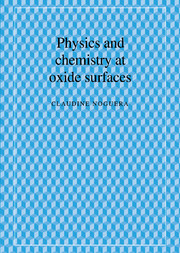5 - Metal–oxide interfaces
Published online by Cambridge University Press: 24 September 2009
Summary
Introduction
The research field of metal–oxide interfaces is very active, partly because of their important technological applications. For example, in heterogeneous catalysis, oxide powders or porous compounds, such as zeolites, are used as supports for transition metal clusters, because they provide a large – external or internal – specific area of contact with the metal. In many cases, it is also recognized that they modify the cluster reactivity (Dufour and Perdereau, 1988). Oxide surfaces, such as those of MgO or SrTiO3, whose quality and planarity are well controlled, have been used as substrates for the deposition of thin superconductor films. This has been particularly important since the discovery that some copper oxide based compounds remain superconductors above liquid nitrogen temperature. Thin metallic films are also deposited on various oxides in the fabrication of optical devices, or on glass in the fabrication of mirrors.
Oxides are often chosen as insulation materials, for example as sheaths for resistive heaters, due to their low electrical and thermal conductivity. In MOS transitors (MOS = Metal–Oxide–Semi-conductor), a thin SiO2 layer is deposited between a doped silicon substrate and the metallic gate to control the channel conductivity. In more complicated electronic devices, with several integration levels, SiO2 is also used to make insulating dielectric layers.
- Type
- Chapter
- Information
- Physics and Chemistry at Oxide Surfaces , pp. 128 - 159Publisher: Cambridge University PressPrint publication year: 1996
- 2
- Cited by



